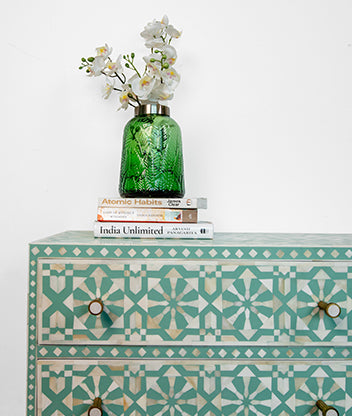
What is a bone inlay?
Bone inlay is a decorative technique that requires an artisan to hand-carve pieces of bone into small shapes. They then embed those shapes into the surface of an object, such as furniture & homewares.
Bone shards were initially laid in mosaic designs that were simple and organic, but the practice eventually came to welcome complex geometric, floral, fishtail, and herringbone installations. The colored resin then fills the space around the bone to create a smooth finish.
The bone inlay furniture and homewares are a part of the Rooh for Space's primary collection. Since the start, they've worked with artisans in Rajasthan to recreate traditional patterns and create their own patterns on their unique designs.

History of bone inlay
Although evidence suggests the art of bone inlay was present in ancient Egypt and prevalent on the continents of Africa and Asia in the 15th century, in Japan during the 18th century, and then later in Europe, it's largely believed to have originated in Rajasthan, India.
It has been said that Maharajas commissioned elite artisans to encrust furniture and artifacts with bone inlay to furnish the royal palaces of the Northern state to convey their status and wealth.
This art form is sporadic and only exists in 2 small villages of India out of the whole world, and the skill is passed down from generation to generation within a family.
Since then, the craft has become ingrained into the local culture. In addition, today's resurging popularity of bone-inlay furniture has renewed interest in teaching and undertaking this craft, ensuring it's preserved for future generations.

How is bone inlay done?
Like other traditional handicrafts, the art of bone inlay is passed down from generation to generation within families. The same techniques that defined the discipline hundreds of years ago are the very same that are taught today.
However, the style developed by each family of artisans is influenced by the society and place they belong, resulting in unique pieces of art that reflect the cultural identity of the people who create them. All bone inlay – and the carving of bone - is done by hand, and no two pieces are the same.
There is something special about furniture that is not made by a machine or churned out in bulk. Instead, all our bone and mother-of-pearl inlay pieces are uniquely handmade in Rajasthan, India, with each piece taking 3 - 4 weeks to be completed into its own individual work of art. It's an intricate process, and understanding how these pieces are made enhances their beauty and the story behind each beautiful design.
STEP 1 - The first stage of the process is creating the wooden frame of the product. The frame is made of wood, while the rest is made of high-quality MDF.
MDF is used in our inlay products because it stands better in changes of heat and humidity. If an entirely wooden frame was used, this would expand and contract in changing weather and create cracks in the incredible inlay work.
STEP 2 - Individual pieces of bone or mother-of-pearl shell are added to the frame in an intricate pattern. This process is done by hand, with our team of artisans following a design and adding their own quirks and personality to the piece.
STEP 3 - The resin is mixed by hand; we can use any Pantone color.
Once this is ready, it is poured across the product, filling the gaps between the inlay pieces.
STEP 4 - The product is carefully sanded down, and the carved inlay pieces are now visible through the resin.
STEP 5 - Final quality control is undertaken, the final polish and varnish are completed, and a layer of wax seals the final product.
STEP 6 - Your beautiful and one-of-a-kind piece is ready to be delivered!
At ROOH, we ensure quality control before it's dispatched to ensure we're only sending our customers the most spectacular inlay pieces.

How are the bones sourced?
The bones used are predominantly sourced from the discarded carcasses of buffalo and camels that have died of natural causes. The species chosen depends on the origin of the artisans. It's described as an environmentally-sound practice that inflicts no cruelty upon animals and a practical yet sustainable form of recycling.

